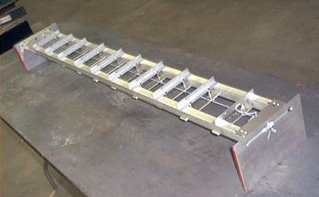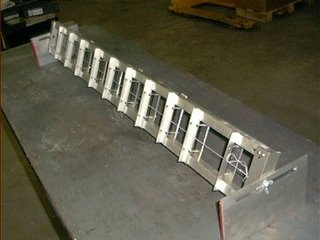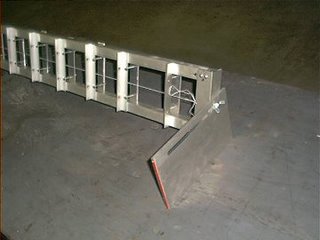Tank Notes on Star Boats: "ROUND chines add another complication to getting speed from a hull. This bad feature is an extension of the range in which burble will appear. In the wake of any transom-sterned boat, a severe agitation of the water may be noticed, an indication that a breakdown is occurring in the flow of water under the boat. When water is released from the transom properly, the burble that means an increase in resistance is not present. However, it is possible to run without burble only above and below definite speeds, the range depending on the lines of the boat. But, also, the shape of the chine has some effect. With a square-chined Star, it is safe to say that the burble will appear at about 5 knots and run clear aft at about 6 1/2 knots (when the boat is upright and on the designed trim). Increasing the bilge radius to 3 inches, on a Star, increases the burble range by dropping the lower limit to 4 1/2 knots and by raising the upper limit to 7 1/2 knots. Also, a model with round chines, when running heeled, begins to climb out of the water forward as the speed increases, the round chine acting as a flat surface on which the model tries to plane. To complete the analysis, it is necessary to go back to sharp-chined heeled models, in which the burble range is from 4 1/2 to 6 1/2 knots.
With the sharp-chined models, there was no indication that the bow tried to rise, a further proof that the sharp entrance angles are imperative. The easiest way to decrease the burble range is to trim the boat by the head and, conversely, the handicap of a trim by the stern is that it will cause the water to break away from the transom at speeds lower than normal. Under all conditions except that of a rounded chine, the burble range increases by dropping the lower limit; the upper limit is quite constant, being 6 1/2 knots. Interestingly, that is approximately the speed at which some styles of Star hulls show the first signs of planing.
In summary, it can be said that many Star boat owners might have had a faster boat than the standard Star because:
1. The fore and aft contour of the boat had been flattened and a large decrease in resistance accrued.
2. The boat was sailed down by the head, at least while running, which would give a 12 per cent decrease in the power required to drive her.
3. Square chines might have been used, which mean a decrease in resistance.
Although this work was done directly on Stars, the information is also applicable to other types of square-chined boats.
But it must always be remembered that, even though a skipper have all the information in the world and his boat has an enviable heritage from designer and builder, the combination must sail hard to be a winner."
Complete article on www.starclass.org/






